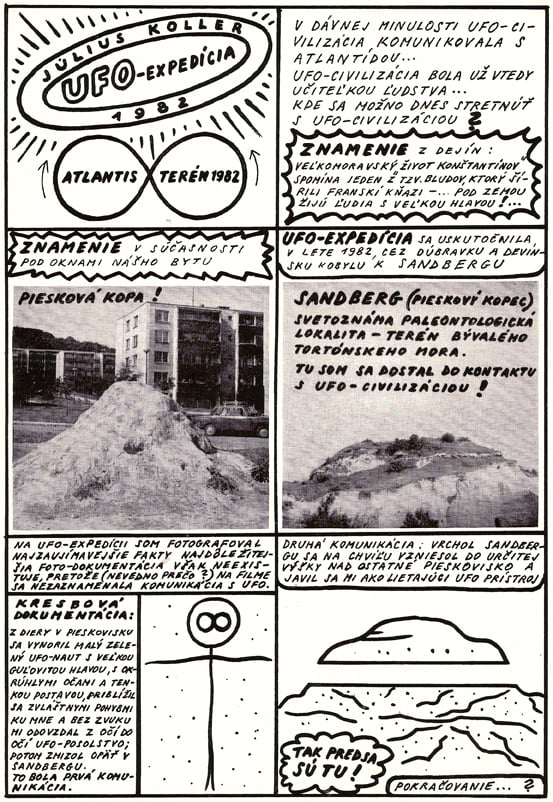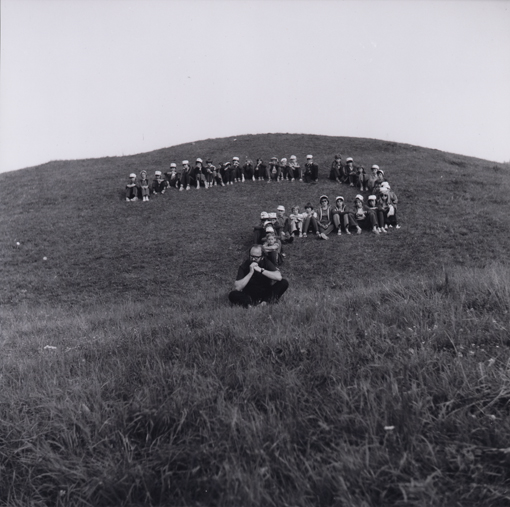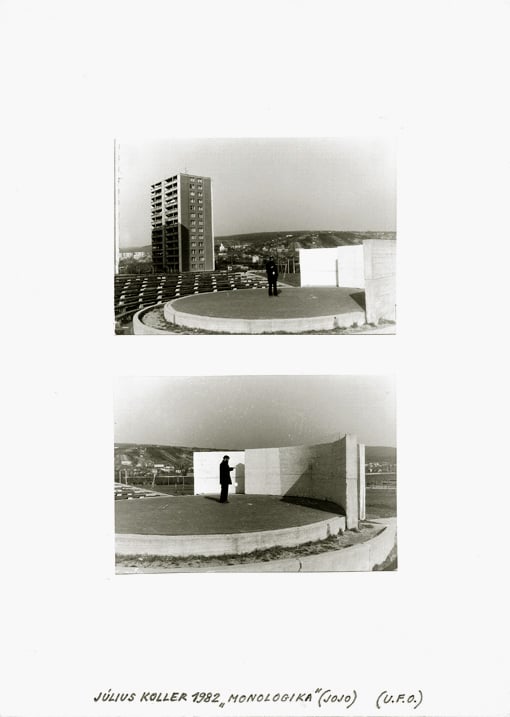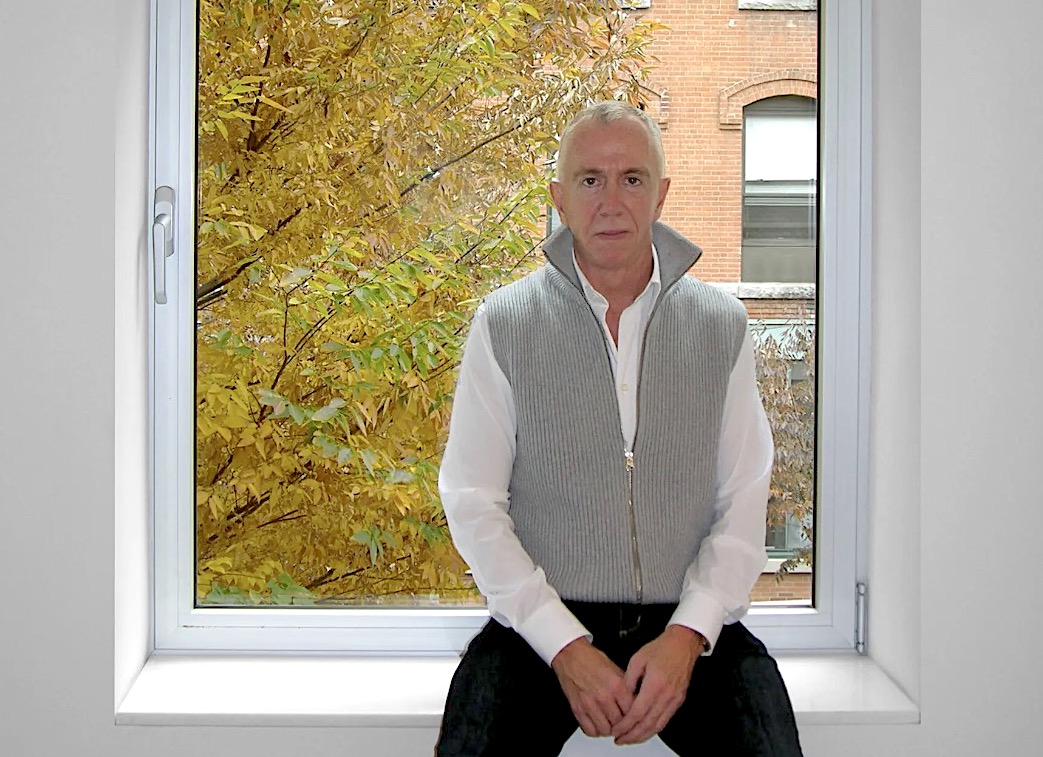
© » KADIST
Volker Eichelmann
In his new series of collages, Eichelmann takes his starting point from the “Belvedere Torso” in the Vatican Museum. In taking over and consuming the image of the sculpture, Eichelmann deconstructs its appearance by cutting it up, covering it, rendering the sculpture an allegorical ruin. Subverting the autonomy of the ancient sculpture in art history, Eichelmann creates a palimpsest through adding a new layer to the work in deconstructing and collapsing the famous sculpture.

© » KADIST
Julius Koller
Wordplay was a central focus of Koller’s work, in particular the acronym U. F. O, which he adapted in his diagrammatic drawings to stand variously for Univerzálna Futurologická Organizácia (Universal Futurological Organization, 1972–3), Univerzálny Filozoficky Ornament (Universal Philosophical Ornament, 1978) or Underground Fantastic Organization (1975), and which also appeared in a series of slapsticky self-portraits titled ‘U. F. O.–naut’ (1970–2007). These infinite variations on a common cipher constituted an insistent incantation of the Utopian principle.

© » KADIST
Julius Koller
Drawing & Print (Drawing & Print)
Wordplay was a central focus of Koller’s work, in particular the acronym U. F. O., which he adapted in his diagrammatic drawings to stand variously for Univerzálna Futurologická Organizácia (Universal Futurological Organization, 1972–3), Univerzálny Filozoficky Ornament (Universal Philosophical Ornament, 1978) or Underground Fantastic Organization (1975), and which also appeared in a series of slapsticky self-portraits titled ‘U. F. O.–naut’ (1970–2007). These infinite variations on a common cipher constituted an insistent incantation of the Utopian principle.

© » KADIST
Kelley Walker
The triptych Black Star Press is part of the series ‘The Black Star Press project’ initiated in 2004 by the American artist Kelley Walker. The images in this series are taken from a photo essay on the struggle for civil rights in Alabama, directed by Charles Moore in 1962 (and published by the magazine ‘Life’) which showed the repression of the black population and persistent inequalities in the southern United States. The title “Black Star Press” is taken from the name of the news agency where Charles Moore worked, and it refers to the young black man shot fighting for the rights of his community.

© » KADIST
Kara Walker
In her masterpiece 8 Possible Beginnings or The Creation of African-America , Walker unravels just that, the story of struggle, oppression, escape and the complexities of power dynamics in the history following slave trade in America. Her use of contour and silhouette accentuate emotion with rigor, she reduces the narrative to black and white as gruesome acts of sex and violence address trauma, fear and suffering through a majestic play of shadow and light.

© » KADIST
Julius Koller
This work is one of Koller’s many variations which he began to use from 1970 to describe the ‘cultural situations’ he created. His “Anti-Happenings” turned mundane events into ‘cultural’ and ‘subjective’ situations. He sought to create new cultural situations that weren’t new art, but rather new ways of living: a new creativity for a new humanistic culture.

© » KADIST
Richard T. Walker
let this be us is a single-channel video by Richard T. Walker featuring the artist himself roaming around the wilderness of a deserted landscape, sporadically humming a melody, strumming a guitar, or playing a few notes on a keyboard. As he traverses between striking locations we see him carrying large photographic prints of the same landscape that he is treading, which he then rests onto tripods so that the horizon in the photograph seamlessly matches that of the real landscape. As we hear the music, Walker comes in and out of view, dissipating into the landscape as his body becomes invisible, hidden behind the photographic prints.

© » KADIST
Colter Jacobsen
Victory at Sea is a simple mechanism made from cardboard and found materials that mimics the Phenakistoscope, an early cinematic apparatus. The piece requires the viewer to turn a wheel and look through a small hole in order to see a briefly animated succession of small drawings of sailors.

© » KADIST
Colter Jacobsen
Drawing & Print (Drawing & Print)
The title Untitled Passport II was first used by Felix Gonzalez-Torres in an unlimited edition of small booklets, each containing sequenced photographs of a soaring bird against an open sky. Stacked in the shape of a cube and available for visitors to take away, the passports did not offer citizenship, but rather invited participation in a sense of borderless “being.” Colter Jacobsen’s Untitled (Untitled Passport II) is a diptych showing two-page spreads from Gonzalez-Torres’s booklet. The perfect graphite renderings freeze the book with its pages splayed, wings perpetually open.

© » KADIST
Julius Koller
The photograph Monologic – Yo-Yo 1, 2 (U. F. O. ), (1982), shows Koller playing with a big white Yo-Yo in a drab concrete building among a group of tower blocks.

© » KADIST
Julius Koller
Drawing & Print (Drawing & Print)
Anti-Happening refers to Koller’s 1965 manifesto, ‘Anti-Happening (System of Subjective Objectivity)’. In opposition to the notion of a ‘happening’ as a way of actualising group identity, in his manifesto, Koller stated that his concept of the ‘anti-happening’ aimed at a ‘cultural reshaping of the subject, at awareness, at the surroundings and the real world’ [i] . Unlike happenings, these actions do not involve the staging of psychologically expressive performances.

© » KADIST
Finger Pointing Worker
During Summer 2011, few months after the nuclear accident, performance artist Kota Takeuchi got a job at the Fukushima Daiichi plant and kept a blog about the labour conditions of clean-up workers. In 2012, he exhibited an ‘anonymous’ video taken from the 24-hour live feed on TEPCO’s website that monitored the clean-up activities. The video, which then went viral in Japan and became known as the “Finger Pointing Worker”, captured someone in a protective suit, entering the frame and pointing his finger at the video surveillance installed by TEPCO on the nuclear plant site.
Julius Koller
- location: Pieštany, Slovenská Republika
- year born: 1939
- gender: male
- nationality: Slovakian
Colter Jacobsen
Since 2003, Colter Jacobsen has gained in visibility and importance in the Bay Area art scene...
Kara Walker
- location: New York, New York
- year born: 1969
- gender: female
- nationality: American
- home town: Stockton, California
Kelley Walker
- location: Columbus, United States
- year born: 1969
- gender: male
- nationality: American
Volker Eichelmann
Volker Eichelmann (b...
Richard T. Walker
- location: San Francisco, California
- year born: 1977
- gender: male
- nationality: British
Finger Pointing Worker
“Finger Pointing Worker” is a man who pointed at the public live camera in Fukushima nuclear power station after the disaster in 2011...

© » ARTLYST
about 4 months ago (01/17/2024)
Brent Sikkema, the Manhattan art dealer renowned for representing artists such as Jeffrey Gibson and Kara Walker found dead The post Brent Sikkema – Visionary Art Dealer Of Jeffrey Gibson And Kara Walker Murdered appeared first on Artlyst ....
-
-
1970-1979
Julius Koller
1978This work is one of Koller’s many variations which he began to use from 1970 to describe the ‘cultural situations’ he created...
-
1980-1989
Julius Koller
Drawing & Print
1982(Drawing & Print) Wordplay was a central focus of Koller’s work, in particular the acronym U...
-
2000-2009
Kelley Walker
2004The triptych Black Star Press is part of the series ‘The Black Star Press project’ initiated in 2004 by the American artist Kelley Walker...
Kara Walker
2005In her masterpiece 8 Possible Beginnings or The Creation of African-America , Walker unravels just that, the story of struggle, oppression, escape and the complexities of power dynamics in the history following slave trade in America...
Colter Jacobsen
2007Victory at Sea is a simple mechanism made from cardboard and found materials that mimics the Phenakistoscope, an early cinematic apparatus...
-
2010-2019
Colter Jacobsen
Drawing & Print
2010(Drawing & Print) The title Untitled Passport II was first used by Felix Gonzalez-Torres in an unlimited edition of small booklets, each containing sequenced photographs of a soaring bird against an open sky...
Finger Pointing Worker
2011During Summer 2011, few months after the nuclear accident, performance artist Kota Takeuchi got a job at the Fukushima Daiichi plant and kept a blog about the labour conditions of clean-up workers...
Volker Eichelmann
2014In his new series of collages, Eichelmann takes his starting point from the “Belvedere Torso” in the Vatican Museum...
